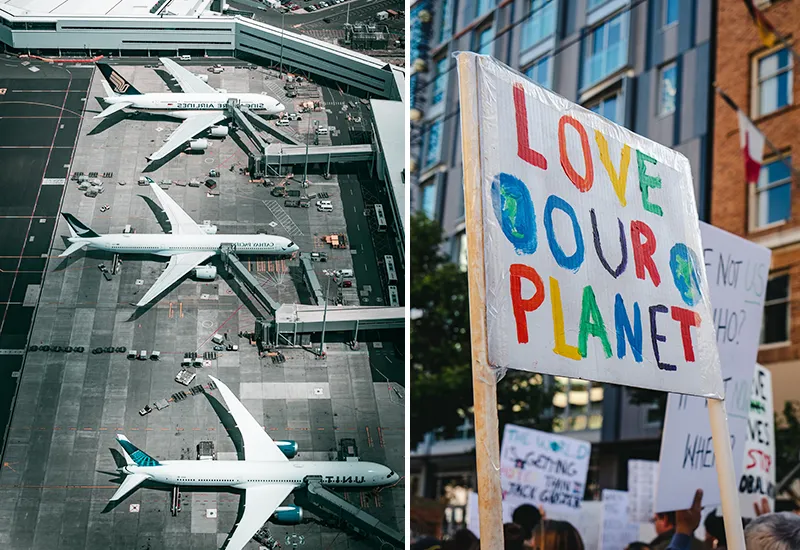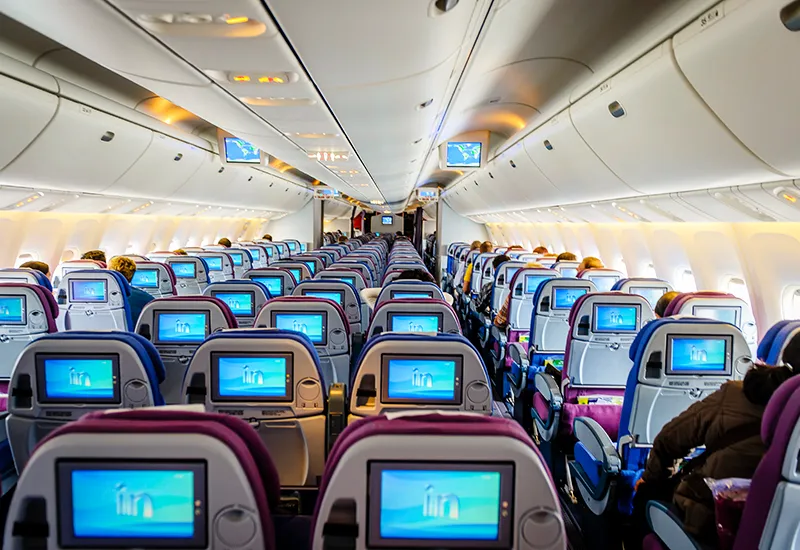Is it actually possible to fly sustainably? Wenn du eine klare Antwort auf diese berechtigte Frage suchst, bist du hier genau richtig! Es ist allgemein bekannt, dass das Flugzeug unser mit großem Abstand klimaschädlichstes Fortbewegungsmittel ist. Und solange es keine alternativen, grünen Treibstoffe gibt, ist es unmöglich, damit umweltfreundlich von A nach B zu gelangen.
Dennoch gibt es natürlich einige Dinge, die du beherzigen kannst, um deine Flugreisen in Zukunft wenigstens nachhaltigER zu gestalten! Sowohl vor, als auch während und sogar nach dem Flug stehen dir echt viele Möglichkeiten parat.
In diesem Artikel möchte ich dir jetzt die besten Tipps für möglichst nachhaltiges Fliegen vorstellen. Nutze sie einfach bei deiner nächsten Reise mit dem Flugzeug, um trotz des Flugs einen echten Unterschied für den Umweltschutz zu machen. Auf geht's!
Advantages: Why should you fly as sustainably as possible?

Zunächst einmal möchte ich dir sagen, dass ich es persönlich schon großartig finde, dass du diesen Artikel liest. Das zeigt, dass du ein gesundes Environmental awareness hast und grundsätzlich bereit bist, zum Schutz der Natur, etwas an deinen Gewohnheiten zu verändern.
Bevor wir gleich zu den konkreten Tipps für nachhaltiges Fliegen gleiten, möchte ich dir an dieser Stelle noch einmal kurz erläutern, warum das überhaupt wichtig ist and underpin why there is such a thing as a lasting shame – die sogenannte „Flugscham“ – überhaupt gibt.
Here I have you the main advantages aufgelistet, von denen du durch den Verzicht auf den ein oder anderen Flug – oder bewussteres Fliegen – profitieren kannst:
- Klima schützen: About 4.9 percent of the global warming sind Studien zufolge auf die Treibhausgas-Emmissionen aus dem Luftverkehr zurückzuführen.1 Deine Entscheidung, nachhaltiger oder gar nicht mehr zu fliegen, trägt also zum Klimaschutz bei – und verbessert deinen persönlichen, ecological footprint.
- Privileg wertschätzen: Rund 90 Prozent der Weltbevölkerung haben noch nie in einem Flugzeug gesessen.2 Dementsprechend ist bewusstes Fliegen auch ein Statement des Respekts und des Verantwortungsbewusstseins für diejenigen, die nicht fliegen (können).
- Vorbild für andere Menschen und zukünftige Generationen sein: Ein umweltbewusster Umgang mit Flugangeboten zeigt, dass du bereit bist, deine Gewohnheiten für den Schutz der Umwelt und das Wohl unserer Kinder und Enkelkinder zu ändern – und in gewisser Hinsicht auch Einschränkungen in Kauf zu nehmen. Außerdem gehst du mit gutem Beispiel voran und zeigst anderen Menschen, wie man bewusster fliegt.
- Umweltfreundlicheren Flugverkehr fördern: Deine Nachfrage nach nachhaltigeren Flugoptionen beschleunigt schlussendlich auch die Entwicklung und Implementierung umweltfreundlicher Technologien und Treibstoffe, sodass ökologisches Fliegen in Zukunft immer wahrscheinlicher wird.
10 Tipps: Wie kann ich möglichst nachhaltig fliegen?

Leider haben viele Menschen den Eindruck, für mehr Nachhaltigkeit voll und ganz auf das Fliegen verzichten zu müssen – dabei ist das gar nicht notwendig. Wir müssen nur begreifen, dass das Fliegen nicht wie alltägliches Busfahren ist. Die wenigen Male, die wir dann ins Flugzeug steigen, sollten wir stattdessen bewusster wählen und eine Flugreise als das begreifen, was sie ist: ein Privileg.
Da du spätestens jetzt die unmittelbaren Folgen der „Vielfliegerei“ und die Vorteile des bewussten und möglichst nachhaltigen Fliegens kennst, können wir den nächsten Schritt gehen. Nutze einfach die folgenden Tipps, um der Umwelt mit deinen Flügen zukünftig möglichst wenig zur Last zu fallen.
1. only fly if it is unavoidable
Natürlich ist es ein löblicher Ansatzto simply not get on the plane at all in order to avoid the Counteract climate change. Doch nicht in allen Situationen unseres Alltags lässt sich eine Flugreise vermeiden. Deshalb solltest du die folgende Grundregel beherzigen: Fly only if there is no other way.
Vermeidbar sind vor allem Kurzstreckenflüge! Denn schon ein Inlandsflug von Berlin nach München bläst etwa 298 Kilogramm CO2 pro Kopf in die Atmosphäre. Eine Zugfahrt über die gleiche Strecke verursacht vergleichsweise nur 34,4 Kilogramm CO2 pro Person and even takes you directly to the city center.3 Der Flughafen ist in der Regel am Rande der Stadt, sodass eine zusätzliche Fahrt mit dem Taxi oder der Bahn notwendig wird.
Nachhaltig zu fliegen, bedeutet außerdem, über den Zweck deiner nächsten Urlaubsreise nachzudenken. Suche dir gegebenenfalls einfach alternative Reiseziele. Wenn du beispielsweise lediglich einen entspannten Strandurlaub oder eine Wanderung in der Natur planst, dann kannst das auch wunderbar in Deutschland bzw. Europa machen. Nord- und Ostsee, zahlreiche Seen und wunderschöne Berglandschaften laden ein. Ein Flug wäre in solchen Fällen also definitiv vermeidbar.
2. Angemessenes Verhältnis zwischen Reisedistanz und Reisedauer bewahren
Je länger dein Aufenthalt an deinem Reiseort ist, desto mehr lohnt sich auch der Flug. Diese Aussage stimmt – natürlich immer unter der Prämisse, dass der Reisezweck auch einen Mehrwert für dich und im besten Fall auch für unsere Umwelt darstellt.
It simply makes no sense, nur für eine Woche erholsamen Strandurlaub um die halbe Welt nach Bali und dann wieder zurück zu fliegen. Die Woche kannst du auch ohne Reisestrapazen an der deutschen Nord- oder Ostseeküste entspannen.
Für längere Reisedistanzen solltest du nach Möglichkeit einen Aufenthalt von drei Wochen oder länger einplanen, damit sich die stundenlange Flugreise auch wirklich lohnt – und zwar sowohl finanziell, als auch ökologisch.
Notice: In the article about sustainable travel you'll get even more information on how to make your vacation basically environmentally friendly.
3. pack only what you really need
Jedes Kilo zählt! Je schwerer du und dein Gepäck seid, desto größer ist auch der Kerosinverbrauch des Flugzeugs – und die Belastung für die Umwelt, die durch deinen Flug entsteht.
That's why, when it comes to sustainable air travel, you should really only das absolut Nötigste in deinen Koffer und das Handgepäck packen. Hier hilft es dementsprechend, ganz im Sinne des minimalist lifestyle to think and plan.
Wenn du in den Urlaub fliegst, dann brauchst du zum Beispiel für drei Wochen nicht 21 T-Shirts, zehn Pullover und acht Hosen. Schließlich lassen sich manche Sachen mehrmals tragen und vor Ort waschen. So just plan ahead a little more preciselywhat should realistically be in your suitcase.
4. stay within your climate budget
According to the non-profit organization "atmosfair", every person is entitled to a Climate budget of around 2.3 tons of CO2 per year zu. Dieser Wert wurde von der globalen Staatengemeinschaft festgelegt, um die Erderwärmung auf 2 Grad Celsius gegenüber dem vorindustriellen Niveau zu begrenzen.4
Neben den Emissionen durch Flüge beinhaltet das personal climate budget The environmental impact of your Electricity, your Car trips or your Food.
In my opinion, the climate budget is a Important point of reference, um die Auswirkungen des eigenen Verhaltens besser einschätzen zu können und um unsere Gesellschaft aufzuklären. Doch du musst natürlich selbst darauf achten, dass du innerhalb deines Budgets bleibst.
Tip: Like to use this CO2 calculator of the Federal Environment Agency, um mehr über deine CO2-Bilanz und dein persönliches Verbesserungspotential zu erfahren. Zudem empfehle ich dir auch noch den Artikel über sustainable drivingif you are in your Not living without a car get by.
5. fly direct and economy class only

Flying is not just flying! The CO2-Ausstoß pro Person ist logischerweise wesentlich größer, wenn du in einen Privatflieger steigst – aber auch, wenn du First- oder Business-Class fliegst. So verbraucht beispielsweise ein Flug nach Thailand und zurück in der Economy-Class etwa 3,3 Tonnen CO2. In der Business-Class liegt der CO2-Ausstoß pro Kopf bei 6,3 Tonnen und in der First-Class sogar bei 9,8 Tonnen.5
Why is that? Your seat takes up at least twice as much space in the more expensive flight classes, wie in der Economy-Class. Wenn alle Economy fliegen würden, könnten also wesentlich mehr Menschen transportiert werden, sodass sich der CO2-Fußabdruck aller Passagiere reduzieren würde.
Außerdem ist es ratsam, Direktflüge zu bevorzugen. Ansonsten müssen für dich zwei Flugzeuge einen Start und Steigflug hinlegen. In diesen Momenten entstehen noch wesentlich mehr CO2-Emissionen, als während der normalen Flugzeit.
6. Fluggesellschaft mit Bedacht wählen
Die Umweltbelastung eines Fluges kann sich je nach Fluggesellschaft trotz gleicher Reisedistanz deutlich unterscheiden. Eine besondere Rolle spielt dabei die Maschine, mit der du fliegst. Bevor du dich also für einen Flug entscheidest, kannst du die jeweiligen Aircraft types simply put it in a CO2-calculator and compare.
Doch natürlich haben also other factors (z.B. durchschnittliche Passagierzahl pro Flieger oder die Höhe der Subventionen) ihren Anteil an der tatsächlichen Nachhaltigkeit eines Fluges. Wirf am besten einfach mal einen Blick auf den atmosfair Airline Index, der die ökologische Leistung von Fluggesellschaften in Effizienzklassen einteilt und Aufschluss über die derzeit klima- und umweltfreundlichsten Airlines gibt.
7. Im Flugzeug Müll vermeiden
Wenn du schon nicht um einen Flug herum kommst, kannst du unterwegs wenigstens den üblichen Disposable waste aus Tickets, Plastikbechern, Besteck und Erfrischungstüchern vermeiden. Plastic-free flying is really not that difficult!
The Ticket are now also available from all airlines as a digital PDF or on the airline's own app. Simply take your own Drinking bottle mit ins Flugzeug, die du dir vorher am Wasserhahn nach der Kontrolle auffüllst. (Here is my absolute recommendation!)
Aus eigener Erfahrung weiß ich zum Beispiel, dass Turkish Airlines auf den eigenen Flügen Stainless steel cutlery zur Müllvermeidung anbietet. Das ist leider noch nicht bei allen Fluggesellschaften so üblich. Für den Fall der Fälle kannst du dir zum Beispiel einen solchen Göffel* which can replace real disposable cutlery when traveling.
With a reusable Fabric napkin bist du dann im Flugzeug sogar noch nachhaltiger. Du kannst dir übrigens sogar dein Essen vorkochen und in einer Edelstahlbrotdose mitnehmen – auch für den Fall, dass es keine vegan/vegetarian options gives.
Tip: Do you already know the Zero Waste Basic Equipment? Lass dich inspirieren und vermeide mit ein paar wenigen Dingen jede Menge Müll – ob im Flugzeug oder im gewohnten Alltag. Und sicherlich hilft dir auch der Artikel über das Zero Waste Travel on!
8. offset CO2 emissions
A short input into the atmosfair emissions calculator zeigt: ein Flug von Berlin nach Mumbai schießt pro Kopf etwa 1.488 Kilogramm CO2 in die Erdatmosphäre. Da ich diese Reisedistanz im Normalfall nicht mit dem Fahrrad oder dem Zug meistern kann, kompensiere ich den notwendigen Flug stattdessen durch eine Spende an die Organisation, die das Money invested in climate protection projects.
Atmosfair schlägt mir in diesem Fall 35 Euro als ökologische Ausgleichszahlung vor. Mit der freiwilligen Spende fördere ich Projekte aus den Bereichen renewable energies and Environmental Education.
Natürlich ist es nachhaltiger, gar nicht erst zu fliegen. But offsetting per capita emissions through donations to environmental organizations is definitely more environmentally friendly than doing nothing at all.
Notice: You can also apply to other organizations for your Offset CO2 emissions. Achte aber unbedingt darauf, dass die unterstützten Klimaschutzprojekte mit dem strengen Gütesiegel CDM Gold Standard zertifiziert werden. Diesen und weitere wichtige Tipps für den CO2-Ausgleich erläutere ich dir auch noch einmal im verlinkten Artikel.
9. Am Reiseziel möglichst nachhaltig verhalten
Versuche, dass der Flug bei deiner Reise das einzige bleibt, dass die Umwelt stark belastet. Ziehe an deinem Reiseort nach Möglichkeit das Fahrrad oder die öffentlichen Verkehrsmittel vor und consume locally and regionally. Das gilt sowohl für Lebensmittel als auch andere Waren. Und wenn du Mitbringsel suchst, bevorzuge sustainable souvenirs.
Sorge einfach dafür, dass dein ökologischer Fußabdruck trotz der Flugreise möglichst gering bleibt. Dafür gibt es countless possibilities! Depending on where you are traveling to, you can also use a Organize own CleanUp, in order to fight against the Plastic waste in the environment to proceed.
Tip: Have a look at my CleanUp Diary in Indonesia – dort war ich drei Monate und habe beinahe täglich Aufräumaktionen unterstützt oder geplant.
10. Flug nicht als Ausrede für weniger Nachhaltigkeit verwenden
"You're already flying anyway, so you don't need to pay any more attention to sustainability on site..." – hast du solche Sprüche auch schon mal gehört? Wer so denkt, nutzt den klimaschädlichen Flug als billige Ausrede dafür, gar nicht mehr auf Nachhaltigkeit achten zu müssen.
And yet you should be more conscious and more sustainable behaviorwhen you get on the plane. Tatsächlich gibt jede kleine, positive Tat an deinem Reiseziel dem Flug einen weiteren Sinn. Gib also immer dein Bestes – ob zu Hause im gewohnten Umfeld oder an für dich neu-entdeckten Orten.
Fly more consciously and sustainably, with simple means!

Natürlich bist du zu Fuß, mit dem Fahrrad oder der Bahn deutlich klimafreundlicher unterwegs, als mit dem Flugzeug. Nutze diese umweltverträglicheren Alternativen whenever they are available.
You should only get on the plane if there is no other option. Beachte für den Fall der Fälle einfach die Tipps, die ich dir heute mit an die Hand gegeben habe, um trotz Flug möglichst nachhaltig unterwegs zu sein.
"The greatest threat to our planet is the belief that someone else will save it."
Robert Swan (more at Environmental protection quotes)
Ich hoffe sehr, dass ich dir mit den Tipps für nachhaltiges Fliegen weiterhelfen konnte. Hast du Fragen, Anregungen oder weitere Tipps? Und wie fliegst du selbst möglichst umweltfreundlich? Ich freue mich auf deinen Kommentar.
Stay sustainable,

PS: Die globale Erwärmung ist das größte der Environmental problems of our time. Doch wir haben noch viele weitere Herausforderungen zu meistern. Informiere dich jetzt als Nächstes zum Beispiel auch über die Overfishing of the seas and what consumers can do about it.
References:
- D. S. Lee, D. W. Fahey, P. M. Forster; u.a. (2009): Atmospheric Environment – Aviation and global climate change in the 21st century, abrufbar unter https://elib.dlr.de/59761/1/lee.pdf. [02.02.2024]. ↩︎
- Bund für Umwelt und Naturschutz Deutschland e.V. (BUND): Reisen ohne Flugzeug: Mit dem Zug entspannt unterwegs (Stand: 19.01.2024), abrufbar unter https://www.bund.net/bund-tipps/detail-tipps/tip/reisen-ohne-flugzeug-mit-dem-zug-entspannt-unterwegs. [02.02.2024]. ↩︎
- co2online gemeinnütztige Beratungsgesellschaft mbH: Bahn oder Flugzeug? (Stand: 16.08.2019), abrufbar unter https://www.co2online.de/klima-schuetzen/mobilitaet/bahn-oder-flugzeug-der-vergleich. [02.02.2024]. ↩︎
- atmosfair gGmbH: Flugreisen und das persönliche Klimabudget, abrufbar unter https://www.atmosfair.de/de/gruenreisen/persoenliches_klimabudget. [02.02.2024]. ↩︎
- F. Wirsing: Flying sustainably, available at https://letsearth.de/blog/nachhaltig-fliegen. [02.02.2024]. ↩︎









Hi Christoph,
vielen Dank für deine Aufstellung! Bzgl. des CO₂ Budgets gibt es ein Update – wenn man deine Quelle liest, werden 1,5 t CO₂ Äquivalent pro Jahr pro Kopf angegeben, um das 1,5 °C Ziel zu erreichen. Ja, du hast 2 °C genannt, evtl. ist es da höher, allerdings liest man das nicht in deiner Quelle. 🙂 Evtl. wäre hier ein Update im Text sinnvoll.
Thanks again, points 4 and 5 were not on my radar.
Best regards
Gabriel
Hey Gabriel, ich danke dir! Update für den Artikel ist auf dem Plan! 🙂
Many greetings
Christoph
Hello Christoph,
Thanks for the great post!
I also always travel with my own water bottle (etc.). The idea with the own cutlery on the plane I find good, but I just ask myself the question which cutlery you use here?
Because normal cutlery or a knife is taken from you at the security check at the airport. Do you have a special "travel cutlery" which you can easily carry in your hand luggage?
Love greetings
Saby
Hey Saby! Thanks for your great feedback and attitude! Yes, there are for example wooden travel cutlery in a narrow fabric bag. You can usually carry that in your hand luggage without any problems.
Many greetings
Christoph
Bringing your own cutlery and food is unfortunately pointless, because the food is still produced and flown along. In the end, however, the portion is thrown away instead of eaten. Also not sustainable!
Similar with cutlery. Your unused packaged plastic cutlery is not picked out of the trays to be reused, it is discarded unused.
So it's more greenwashing for the conscience.
However, it is worth having your own glass or cup with you to avoid the countless plastic glasses and cups that are handed to you in between drinks.
Greetings Lena
Hey Lena, thanks for your comment. With cutlery you have to be quick and return it directly. But you're probably right about the food, but with some airlines you can say in advance that you don't want any food. We will probably have to keep pushing and wait until the idea of sustainability has really become second nature to the airlines.
Exactly, with the cups it makes sense either way to have your own with you.
Thank you for your advice,
Greeting Christoph
Comments are closed.